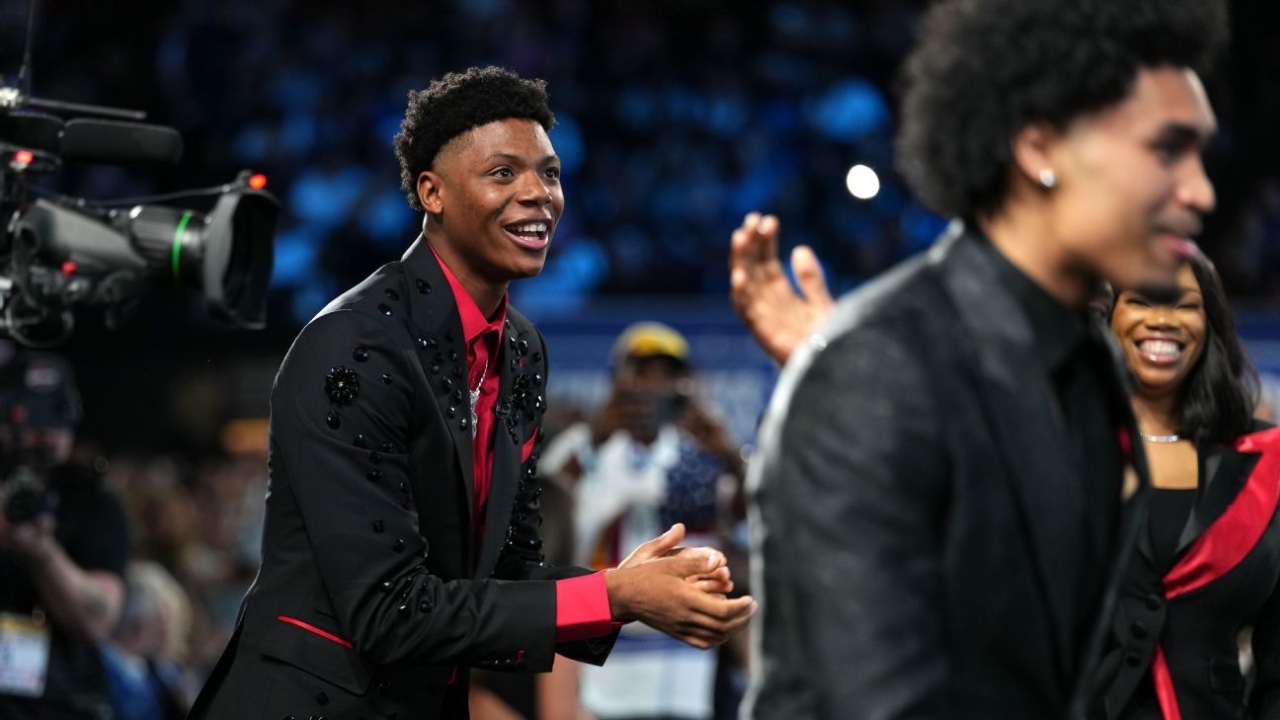2025 NBA draft reactions from college basketball coaches

Should there be on-court concerns about Ace Bailey at the next level? How do Tre Johnson and Jeremiah Fears translate in the NBA? Were Egor Demin and Cedric Coward deserving of lottery selections?
To answer some of the burning questions following the 2025 NBA draft, ESPN spoke to nearly a dozen college basketball coaches — the people who have watched and game-planned against these players for the past few years — about the biggest storylines and top prospects.
Jump to:
The top two picks
The next tier of picks
More first-round storylines
Other notable first-rounders
Second-round notes



Cooper Flagg, Dylan Harper in their own tiers
Since Flagg announced in August 2023 that he planned to reclassify into the 2024 high school class, there has been very little question about the top of this class. Considered one of the best high school prospects in recent memory, Flagg had been the favorite to be selected No. 1 for the past two years, with the Dallas Mavericks making that official Wednesday. He was the best player in college basketball last season, winning the Wooden Award and leading Duke to the Final Four. He averaged 19.2 points, 7.5 rebounds and 4.2 assists, answering questions about his shooting by making 38.5% of his perimeter attempts.
Opposing college coaches have zero doubts about his ability to translate to the NBA level.
“He’s got a swagger to him, a toughness and he’s physically ready to make an impact,” one coach told ESPN. “For a young kid going to the NBA, if he’s never been in a situation where he’s been the guy, it’s hard to flip a switch. But he’s been in every single one of those situations. Playing off ball screens, coming off pindowns, rebounding and going. Showed his versatility all year long. He’s done all that stuff at the highest level of college basketball.”
Coming out of high school, Flagg’s shooting was something of a question, but the Maine native improved as his freshman season in Durham progressed. He shot 44% from behind the arc in ACC play, making multiple 3s in nine games.
“Early in the year, you could go under a ball screen against him. You weren’t doing that by the end of the year,” another coach said. “The NBA is a big isolation league. So when it comes to individual wiggle and being able to get by guys, he’ll have to figure those things out.”
Coaches also thought Flagg’s landing spot will be a positive for his development, mostly due to the fact he’ll be playing alongside Kyrie Irving and other veterans.
“I think he fits in well,” one coach said. “He won’t be keyed on as the main guy every single night. For a young guy, that can shake your confidence. I’m not worried about that with him.”
Even without being the Mavericks’ top offensive option, Flagg will be the heavy favorite for Rookie of the Year.
“[If he can] just be a well-rounded 15 points, 8 rebounds, 4 assists, 2 steals, a block [contributor] … he’ll win Rookie of the Year,” an ACC coach said, “because Dallas should be good, assuming health.”
Nearly every college coach we spoke with agreed that there was a gap after Flagg at No. 1 and Harper at No. 2 — each in classes of their own.
“[Harper is] as good a player as we’ve played against in the last 10 years, whether you’re going back to Markelle Fultz or talking about Paolo Banchero. He’s better than Jabari Smith. I’m super, super high on him. I think he’s closer to Flagg than No. 3 is to him,” one opposing coach said of the new San Antonio Spurs guard. “He’s a pick-and-roll maestro. It doesn’t matter what coverage you throw at him, it might take him a possession or two but he’ll find a way to beat it.”
“Flagg and Harper are the only two to me that have an All-NBA ceiling,” another coach added. “There’s such a big drop-off — it’s almost like those next guys are not Tier 3, it’s Tier 4. That’s how big I think the gap is between Dylan and everyone else.”

THE NEXT TIER

No. 3: VJ Edgecombe, 76ers
 play1:25The plays that brought V.J. Edgecombe to the 76ers
play1:25The plays that brought V.J. Edgecombe to the 76ers
Check out some of the top highlights from Baylor freshman V.J. Edgecombe as he’s drafted third overall by the 76ers.
The biggest beneficiary of Bailey’s drop was Edgecombe. The Bahamas native showed off his impressive athleticism throughout his one season at Baylor, improving his offensive consistency and playmaking as the season progressed. Now, he’ll have the chance to join a talented backcourt featuring Tyrese Maxey and Jared McCain.
“Until I saw him in person, I was critical of him. ‘He’s a lock to be a top-five guy?'” one coach said. “And then we played him and he was just relentless. His athleticism, his shot got a lot better as the season went on. Started getting more consistent from the perimeter.”
“He has to be the most athletic player or prospect in the draft,” another added. “He’s a high-flyer, he plays bigger than what he is. He can defend 1 through 5, at least in college. He can probably do the same because the 5s are more mobile. Positional versatility, athleticism and just the way he defends.”
The fit alongside Maxey and McCain could be a concern, although multiple coaches said there could have been questions about his offensive role regardless of landing spot.
“Can he be a primary guy?” one Big 12 coach asked. “He’s not a guy where you can put the ball in his hands and say go get a bucket. He just isn’t that. He’s a slasher, a pick-and-roll guy, great in transition, offensive rebounding, does all the little things. But if there’s one negative, it’s just how is he going to score in the NBA.”

No. 4: Kon Knueppel, Hornets
The second of three Duke players selected in the top 10, Knueppel skyrocketed in mock drafts last fall and maintained that position throughout the Blue Devils’ terrific season. While playing second fiddle to Flagg, Knueppel averaged 14.4 points and shot better than 40% from 3-point range — popping as a shotmaker late in the season and in the NCAA tournament. He was considered the best catch-and-shoot perimeter shooter in the draft. And he has a comfort level with not being a team’s primary offensive option, which could be appealing to Charlotte, where he will play alongside LaMelo Ball and Brandon Miller.
“He was such a difference-maker for Duke last season, being the Robin to Cooper Flagg’s Batman,” one coach said. “When you have a guy capable of dropping 30 in a game and isn’t the main guy on scouting reports, that’s dangerous. The NBA loves guys that can make shots, and if you can do that, you’ll be in the league for a long time.”
While Knueppel’s floor appears high, making him a safe bet for the Hornets, he might not possess the ceiling of the other players in this tier, opposing coaches said. The focus for him moving forward will come at the other end of the floor.
“Guys can get played off the floor [in the NBA],” one coach said. “Can Kon stay on the court guarding in one-on-one situations? He’s got the size and frame, but does he have the footspeed? That’s the one thing you don’t get to see against Duke, with how much they mask things, how much they’re helping. They don’t allow offensive teams a lot of space, so rarely did he have to guard in space. He has to prove he can do that.”

No. 5: Ace Bailey, Jazz
A year ago, it appeared that Bailey would be right in the mix with Flagg and Harper at the top of the board. Bailey showed flashes of that ability during his freshman season at Rutgers, but questions continued to pop up that precipitated a slight drop. He was listed at 6-foot-10 in college but measured at 6-7 1⁄2 at the combine. He was also the only U.S. prospect who didn’t visit an NBA team facility during the predraft process, canceling a scheduled one with the 76ers.
From an on-court perspective, coaches understandably loved his scoring ability.
“He’s versatile, he’s got size, he’s skilled like an off-guard,” one Big Ten coach said. “He’s the prototypical NBA wing. He’s a really tough cover. He can move. Not elite athleticism, but a good athlete. He can shoot over players and the ability to make contested shots adds value.”
But will all of that translate? And what about the other aspects of his game?
“If you’re [Kevin] Durant, sure, [relying on hard shots] can work,” one coach said. “But he’s 7-1. Ace isn’t going to be a stand-in-the-corner guy.”
“The knock on him, whether it was in high school or at Rutgers, is that he’s disengaged defensively,” another Big Ten coach said. “He doesn’t need to become an all-NBA defender. But you need to get buy-in from him defensively.”

No. 6: Tre Johnson, Wizards
Johnson’s offensive ability has kept him in the top half of the lottery conversation for much of the cycle. The former top-five recruit averaged 19.9 points and shot nearly 40% from 3 during his lone season at Texas
While he was the go-to guy offensively for the Longhorns, most opposing coaches think his best role in the NBA — assuming he’s not immediately Washington’s offensive focal point — is as a microwave scorer off the bench or a specialist catch-and-shoot option. The Wizards struggled mightily from the perimeter and just traded Jordan Poole, making Johnson an easy fit.
“He’s a scoring guard, period,” a coach said. “He’s one of the best shooters in the draft. He’ll have to learn that you don’t need to dribble the ball eight times before shooting, but he can be a borderline All-Star because of how well he shoots the ball. He can be a catch-and-shoot guy and shoot 50%.”
The questions about Johnson center around the rest of his game and whether he will contribute enough in other facets to impact winning at the highest level.
“He’s a great individual talent,” another coach added. “But if you’re not scoring, what other things are you doing that help winning? Inevitably the best players in the world are going to have off nights.”

No. 7: Jeremiah Fears, Pelicans
 play1:41Jeremiah Fears’ best plays that led him to the Pelicans
play1:41Jeremiah Fears’ best plays that led him to the Pelicans
Check out Jeremiah Fears’ top plays at Oklahoma as the Pelicans select him with the seventh overall pick.
The freshman out of Oklahoma was the biggest riser of the past 12 months — he wasn’t even in this draft class a year ago, but he opted to reclassify into 2024 and commit to Oklahoma, where he emerged as one of the most dynamic guards in the country despite not turning 18 until October.
“He’s wired to score,” one coach said. “I kind of compare him a little bit to [Nets guard] Cam Thomas. He’s a better playmaker than Thomas was coming out of college. He has the ability to make reads, you can double-team him or trap a ball screen, but he’ll read it perfectly, whereas other freshmen get rattled. He’s a sneaky athlete, too.”
What will determine his ceiling might be his perimeter shooting. He shot 28.4% from 3 on the season, making only 15 shots from 3 in 18 SEC games.
“He’s streaky, not a consistent shooter,” one opposing coach said. “He has to continue to build up his frame, but he’s a young kid, only 18 years old. As he matures physically as he gets older, he’ll be able to take a little bit greater command of the position, get into the paint, deal with physicality. “

MORE FIRST-ROUND STORYLINES

Egor Demin: Lottery’s biggest riser
Had the draft taken place around the start of last college basketball season, the former BYU guard being selected at No. 8 by the Brooklyn Nets wouldn’t have come as a surprise. The Russia native slotted in at No. 7 in ESPN’s November mock draft after generating significant buzz following his arrival from Real Madrid. But an uneven freshman season in Provo caused his stock to fluctuate, ending up at No. 13 in ESPN’s final predraft mock.
On Wednesday, however, Demin found his way back into the top 10.
Opposing coaches were mixed on his ability to contribute immediately at the next level.
“He’s huge,” one Big 12 coach said. “Ball pressure bothers him, he plays pretty upright, he’s methodical. But he can make every read out there. … He’s got a little bit of a burst just because he goes from slow to medium, it throws you off. He’s throwing it over the top of guards. You can say, ‘Oh, that’s college,’ but he’s taller than most guards in the NBA, too. His passing is elite. He’s a better shooter than his percentages. And I think he’ll get better with the space of the NBA.”
“I don’t think he shoots, I don’t think he really defends,” one coach countered. “But people see a big guard who can pass and it’s sort of intriguing.”
Demin was one of five first-round picks for the Nets, with three of them — Demin, Nolan Traore (No. 19) and Ben Saraf (No. 26) — possessing heavy international experience. It was a fascinating haul, given all three were projected in the lottery back in November. “[The Nets are] obviously committed to their international scouting team, taking three guys who were international players who most felt underachieved this year,” one coach said. “There was clearly a belief in who Demin was before he came [to the United States].”

Khaman Maluach: Duke’s third top-10 pick
After Flagg and Knueppel, there was a longer-than-expected wait to hear Maluach’s name, but the Suns ultimately selected him at No. 10. He didn’t have nearly the college production of the other players drafted in the top 10, but his 7-2 size, 9-6 standing reach and 7-6 ¾ wingspan, combined with his defensive potential, are incredibly intriguing to coaches.
“You can throw him out there and he’s going to be able to impact the game with his size and shot-blocking, his defensive and offensive rebounding,” one opposing coach said. “In the NBA game, you have to have a 5-man like that, but the young ones, it’s just going to take him time. He does have some skill, he banged in a 3 early in the year, he has the potential to step out and shoot 3s.”
Another opposing coach questioned how advanced that skill level really is, and whether the perceived ceiling is actually lower in reality.
“I think he’s a lob-catching big. He’s massive, but I don’t think he’s an unbelievable athlete,” the coach said. “He’s not Dereck Lively II, who was a different type of mover, different athlete, had more skill. Maluach is not as good in any of those categories. I don’t think he’s got that same ceiling.”
“He’s still going to be a project at the end of the day,” another coach said.
 play1:36Khaman Maluach’s plays that led him to the Suns
play1:36Khaman Maluach’s plays that led him to the Suns
Check out Khaman Maluach’s highlights from Duke that led him to the Phoenix Suns.
Phoenix will be able to be patient with Maluach, as the franchise also traded two first-rounders to Charlotte for veteran center Mark Williams. But at No. 10, some of the risk is mitigated.
“He’s the type of archetype that usually goes up the board as time goes on,” one coach said. “It remains to be seen whether the shot is something that’s translatable. It doesn’t look bad mechanically, but it hasn’t gotten to the point where he’s taking them or making them with any real consistency. But it wouldn’t shock me if that’s something he was able to do over time.
“I like the vertical threat he presents at the rim as a finisher, I love his shot blocking, the defensive versatility that he has. He has to rebound the ball better. But he’s not someone who is going to come into the league and take his foot off the gas.”

Cedric Coward: From D3 to lottery
Coward was among the most fascinating storylines in the lead-up to the draft. Starting his college career at the Division III level with Willamette University in Oregon, Coward was barely on NBA draft boards at this time last year, having finished up his second season at Eastern Washington in the Big Sky Conference.
Coward transferred to Washington State, where he played just six games before missing the rest of the season because of a shoulder injury. But after emerging as one of the standouts from the combine, he cemented his status as a top-20 pick and opted to remain in the draft instead of playing his final college season at Duke, where he committed out of the portal.
On Wednesday, he was selected No. 11 by the Grizzlies, who traded up to pick him.
“The thing that stuck out to me with him was he got better every year,” one Big Sky coach said. “When he first came in as a D-III transfer, we didn’t really know who he was. [He was] a skinny kid with length, developing his offensive game. He played hard as hell, impacted winning. He started to shoot the ball a little bit better, to the point now where he shot it really well in the short span last year. He kept adding to his game. Little bit more polished, little bit more refined, little bit smoother every time we played him.”
Surrounded by Ja Morant and Jaren Jackson Jr., Coward isn’t going to be asked to shoulder huge offensive responsibility early on, but opposing coaches think he’ll have no problem being a high-end role player in the NBA.
“He has the ability to shoot, legitimately catch-and-shoot,” one coach said. “He’s got the in-between game, he killed us in the post. He can play with a face-up game. He’s a pretty good defender. Blocked a ton of shots. He does so much to impact winning. He doesn’t need to be a guy who carries the load offensively, and I don’t know if he ever will be.”
The big question: Was No. 11 too high for a player who started just eight career games against power-conference opponents?
“Seeing him this year, he looked like a pro. He took a massive jump physically,” said one coach, who added that Coward’s highest-end ceiling shares a lot of the same traits as Kawhi Leonard. “He’s going to help you win in some capacity. He can do a lot to really impact the game, whether it’s off the bench or if he develops into a starting-caliber player. He’s a guy you’re going to bet on.”

Carter Bryant: Most unproven lottery pick
When the 2024-25 college basketball season ended, Bryant seemed like he could go either way with his draft decision. He started just five games as a freshman at Arizona, scoring in double-figures just a handful of times.
As the spring went on, though, it became clear Bryant wasn’t going back to college. His stock steadily rose, from a lock first-rounder into the top 20 and ultimately to No. 14 with the Spurs.
At 6-6 ½ without shoes, Bryant shot nearly 39% from 3-point range in Big 12 play, making multiple 3-pointers in a game nine times after the calendar turned to 2025.
“He’s got the positional size, the athleticism, the shooting, the defensive versatility, with potential to get better,” one Big 12 coach said. “In small doses, he showed some things offensively, that maybe he can be a little bit of a playmaker, he can make some passes. It wasn’t showcased a ton, but he did it enough. Whether it was guarded or unguarded, he’s able to get his shot off. He has room to grow in that area, he needs to continue to speed up his shot, but the NBA loves big wings that can shoot it.”
The Spurs will have to be patient, though, as he’s only shown his ability in flashes.
 play1:43The plays Carter Bryant is bringing to the Spurs
play1:43The plays Carter Bryant is bringing to the Spurs
Check out some of Carter Bryant’s top highlights from his time at Arizona that led to the Spurs drafting him in the first round.
Veterans become higher first-round priority
While the top half of the first round was predictably filled with freshmen — the first eight picks were all first-year college players, and 18 freshmen were selected in the first round — the trend of older players being drafted earlier continued this year.
Coward, Walter Clayton Jr., Nique Clifford, Danny Wolf and Yanic Konan Niederhauser all transferred at least once and played at least three years in college, with Clifford, Clayton and Niederhauser all at least 22. And older college players Ryan Kalkbrenner (No. 34), Johni Broome (No. 35) and Chaz Lanier (No. 37) were picked fairly early in the second round.
The trend really took shape last year, when Zach Edey, Devin Carter, Dalton Knecht, Dillon Jones, Baylor Scheierman and Terrence Shannon Jr. were selected in the first round.
Why is this happening? It’s primarily related to the increased money available to student-athletes at the college level, allowing more players to stay in college, while the increased prevalence of the transfer portal has allowed mid-major stars to shine at higher levels and increase their draft stock.
“Financially, they’re rewarded to stay. It allows them to be a little more ready and polished for the next level,” one coach said. “The high-end guys, the lottery guys, you’re drafting on upside. But if I’m a playoff team, a play-in team and still growing, getting an older, mature guy that you know can help you in a role, that’s a smart bet. You’re still getting a guy in the prime of his career. You get more bang for your buck in Year 1 or 2, maybe not Year 6 or 7.”
This might be one of the final years of the trend, however. A long list of borderline first-round picks opted to return to college at the withdrawal deadline this spring, including Michigan’s Yaxel Lendeborg, Florida’s Alex Condon, Auburn’s Tahaad Pettiford, Alabama’s Labaron Philon and NC State’s Darrion Williams. Duke’s Isaiah Evans, Texas Tech’s JT Toppin and UConn’s Alex Karaban didn’t even go through the draft process.
All of these players — and many others — were compensated handsomely for their decisions to stay in school, but with the House vs. NCAA settlement and salary caps potentially impacting players’ earnings potential in the new revenue-sharing era, will the money to return to college be enough to keep players out of the draft in the future?
“I think it’ll flip back the other way with rev share,” one high-major coach said. “You look at the rev share numbers, a lot of SEC schools are putting most of their money into football. Their rev share numbers are between $2 [million] to $3 million. This year, we had collectives, some of those teams had $10 [million] to $12 million. We had a couple on our team that came back because they’re going to make more money here than going in the second round. But with those numbers going down, those potential first-rounders or high-second rounders, I can see them going to the league instead.”
“I think this will be one of the last years of it,” another coach added. “There are a lot of really good players staying in college because of NIL. Once revenue share kicks into effect and the NIL market gets some stability, you’re going to see a lot more of these fringe first-rounders stay in the draft. It used to be where if you were top 40, 90% of those guys were staying in the draft. Now it’s shifted to where you need to be a top-20 player to stay in.”
One byproduct of all the aforementioned players staying in college as opposed to entering the draft was the lack of surefire hits in the second round. A coach pointed out that 14 second-round picks last year received guaranteed deals, with only two of the first 47 picks landing two-way deals.
That might not be the case this year.
“It’s one of the worst second rounds of all time. A huge part of that is because of NIL,” the coach said. “Go through all the guys that would’ve been late first, early second, it would’ve really moved things. It wasn’t a strong draft to begin with, but with all those guys going back, after No. 35 or so, I don’t know if I would give [many] of these guys a guaranteed deal.”

OTHER NOTABLE FIRST-ROUNDERS

No. 9: Collin Murray-Boyles, Raptors
First non-freshmen picked: Murray-Boyles has a truly unique profile. He measured at just 6-6 ½ without shoes, but he did nearly all of his offensive damage around the basket. He attempted just 39 3-pointers during his 60 games with South Carolina but was dominant in the paint.
Murray-Boyles was able to overcome his size issues in college, making an impact defensively and with his passing, but he’ll have to expand his skill set at the next level.
“He’s got sort of a unique game, and the NBA falls in love with guys who have a little bit of a lot of things,” one coach said. “He’s a guy who has a chance to be a very good defender. He doesn’t have great height, but he has good size in terms of measurements and strength. He can do a little bit of everything, he can pass, he can rebound, he’s not a very good shooter at this point. I think he’s a good player, but I think he’s a blend player. I don’t think, individually, he’s got unbelievable talent where he’s bringing something to the table right away. If he’s on a good team, he can help it function. But I don’t know if Toronto is that.”
 play1:57Collin Murray-Boyles’ best plays that led him to be drafted by the Raptors
play1:57Collin Murray-Boyles’ best plays that led him to be drafted by the Raptors
Check out some of Collin Murray-Boyles’ best moments from South Carolina as the Raptors take him with the tenth pick.



No. 13: Derik Queen, Pelicans
No. 25: Jase Richardson, Magic
No. 27: Danny Wolf, Nets
Mixed reviews: Coaches were split on this trio of Big Ten picks.
Maryland’s Queen established himself as one of the most skilled bigs in college basketball last season, highlighted by his buzzer-beater to knock off Colorado State in the second round of the NCAA tournament. But there are questions about his maturity, and his lack of athleticism could cap his perceived upside.
“He’s so skilled,” one Big Ten coach said. “I love his passing ability. You watch him on film, you think he’s not athletic. But in person, it doesn’t matter. If he’s able to develop a motor, I really think he’s got a chance to be one hell of an NBA player.”
Michigan State’s Richardson saw his stock fluctuate throughout the past few months, rising into the first round and eventually the lottery after Tom Izzo moved him from the bench into the starting lineup in early February. But after measuring at just over 6 feet without shoes at the combine, Richardson’s spot in mocks dropped into the 20s — and he ultimately didn’t receive an invite to the green room.
Orlando bought the dip and selected him at No. 25.
“I like Jase Richardson. He would be a nightmare to coach against in college next year, but I don’t see it [in the NBA],” one Big Ten coach said. “He’s a 6-foot guard whose primary skill is scoring — not shooting, but scoring. He’s not a great defender, not a super dynamic playmaker for others. He’s got below-average size. So is he Trae Young? Is he T.J. McConnell? Is he Davion Mitchell?”
Michigan’s Wolf had one of the more interesting roles in the Big Ten last season, with Dusty May using the 6-11 Yale transfer as a playmaker with the ball in his hands because of his decision-making out of ball screens and passing ability. But there are questions on how it will translate to the next level.
“He can play in pick-and-roll, as a big man he can make incredible passes,” one coach said. “But he’s a high-turnover guy. With his role in the NBA, you’re not going to be able to make an incredible pass and then two bad passes. An NBA team is not going to let him just roll through his turnovers.”
“Part of his beauty is that he can do so many things, but none of it he’s excellent at,” another added. “Will a team try to make him elite at something, or are they OK with the buffet?”

No. 18: Walter Clayton Jr., Jazz
NCAA tournament impact: Clayton’s rise to No. 18 on the heels of an incredible NCAA tournament run was highlighted by one coach. Clayton was unbelievable during Florida’s march to a national championship, averaging 24.6 points in the Gators’ first five tournament games, including 34 points in the Final Four against Auburn and 30 points against Texas Tech.
“He’s a great example of what winning does for a player’s stock,” the coach said. “He went from a mid-to-late second-round pick to a late first-round pick. Florida going on a run, him being able to be on that platform and showcase his talents. That right there made the kid millions and millions of dollars.”


No. 20: Kasparas Jakucionis, Heat
No. 29: Liam McNeeley, Hornets
Biggest slides of opening night: Illinois’ Jakucionis was ranked No. 10 on Jonathan Givony’s Big Board and projected at No. 11 in ESPN’s final predraft mock, while UConn’s McNeeley was No. 17 on Givony’s board and mocked at No. 20, each falling notably below their evaluations. Multiple coaches thought the two could be tremendous values for the teams that landed them.
Jakucionis looked like a legitimate All-American in nonconference play, averaging 16.4 points, 5.6 rebounds and 5.4 assists through 14 games, headlined by a stretch of 20-point outings against Arkansas, Northwestern, Wisconsin, Tennessee and Missouri.
While one Big Ten coach agreed this landing spot was good value for the Heat and a potentially good fit for Jakucionis, alongside Tyler Herro in the backcourt, he also understood the slide.
“He’s a three-level scorer,” the coach said. “He played with a great change of pace. As the season went on and as teams scouted him, he kind of came back down to earth. But he plays with a toughness. He’s not an elite athlete. His stats tailed off the second half of Big Ten play, and he’s someone you could go at and isolate on defense.”
 play1:43Why the Heat like Kasparas Jakucionis
play1:43Why the Heat like Kasparas Jakucionis
Check out some highlights from Kasparas Jakucionis as he heads to the Miami Heat.
McNeeley was a five-star recruit coming out of high school but was hampered by an injury during the middle part of his freshman campaign in Storrs. He’s a shotmaker with size and had some of the best individual performances of any freshman last season: 26 points and eight rebounds against Gonzaga, plus 38 points and 10 rebounds against Creighton.
One Big East coach thought McNeeley’s ankle injury that caused him to miss eight games during conference play impacted his efficiency and effectiveness at both ends of the floor, which might have contributed to his slide.
“I don’t think he’s the 29th-best player in the draft,” he said. “He’s 6-8 and he’s a much better shooter than his percentages suggest. He’s really competitive. I think he’s a little bit better [overall] basketball player than he gets credit for, in terms of his ability to drive the ball and pass the ball.”

No. 22: Drake Powell, Nets
Surprise pick: The North Carolina wing was something of a surprise at No. 22, with the Nets using their third first-round selection on the former five-star recruit. He had an inconsistent role as a freshman for the Tar Heels with 7.4 points per game but tested as arguably the best athlete at the combine, pacing the player pool in both max vertical leap and standing vertical leap.
Can he help Brooklyn immediately? Opposing coaches have questions.
“He fits the prototype of that 3-and-D guy, but is he really good enough at either of those to actually fit that profile?” one ACC coach asked.
“A lot of what people thought about Powell dates back to some of the enthusiasm at the end of his high school career, when people saw a guy who wasn’t a good shooter but had size and versatility. Good passer, some feel, good athlete, maybe the potential to be a big point guard,” one coach added. “And then he gets to North Carolina, and he becomes a full-time wing player with real limitations offensively.”

No. 30: Yanic Konan Niederhauser, Clippers
Made the cut: The Penn State big man capped his meteoric rise by seeing his name taken with the last pick of the first round.
Niederhauser raised his stock as much as anyone during the predraft process, working his way from averaging 12.9 points last season for the Nittany Lions to the G League Elite camp and then earning an invite to the NBA draft combine. Remember, this is a player who averaged 7.3 points at Northern Illinois just two seasons ago.
“He’s just scratching the surface. He’s somebody that can be like a Dereck Lively type in the NBA,” one coach said. “I think if he came back to college, he would’ve been a lottery pick next year.”

SECOND-ROUND NOTES




No. 35 Johni Broome, 76ers
No. 42: Maxime Raynaud, Kings
No. 48: Javon Small, Grizzlies
No. 53: John Tonje, Jazz
Auburn’s Broome, Stanford’s Raynaud, West Virginia’s Small and Wisconsin’s Tonje stood out to coaches as values. Two pointed out that the gap between Broome — a consensus first-team All-American and the perceived runner-up to Flagg for Player of the Year honors — and first-round big men such as Murray-Boyles shouldn’t have been that wide.
“He’s a player that is limited athletically. There’s probably more things people can say about him, age, all this stuff,” one coach said. “But he got Player of the Year in the best league in the country, he went to the Final Four. Some of that has to have some substance at the next level. He did everything that everyone asked. And he produced every night. What else is he supposed to do? He had a historic year in a conference that was historically one of the best ever.”
 play1:36What the 76ers are getting in Johni Broome
play1:36What the 76ers are getting in Johni Broome
Check out some of Johni Broome’s top moments as he is drafted by the 76ers with the 35th pick in the NBA draft.
Raynaud was also one of the most productive players in college basketball last season, averaging 20.2 points and 10.6 rebounds while shooting nearly 35% from 3 at 7-foot-1.
“I like Raynaud. He’s big and can shoot. He can pick and pop. He rebounds,” one coach said. “What can he do defensively? He’s not switchable, he’s not a rim protector, so what does that look like? But offensively he’ll be able to play. He’s a plug-and-play role player.”
Of the group, Tonje had the most circuitous route to the draft. He spent four years at Colorado State, played sparingly at Missouri before suffering an injury, then transferred again to Wisconsin, where he emerged as a consensus first-team All-Big Ten selection.
“His shotmaking is real,” a Big Ten coach said. “I don’t know why people don’t like him.”
Finally, one coach compared Small to former Houston guard Jamal Shead, who made an impact at both ends of the floor for the Raptors in a key bench role as a rookie.
“He’s the consummate backup NBA point guard,” the coach said. “Experience, size, shotmaking ability. Pick-and-roll passer. He should be a better defender, but he’s a good rebounder for a guard.”


No. 33: Sion James, Hornets
No. 43: Jamir Watkins, Jazz
Two ACC wings, James from Duke and Watkins from Florida State, drew praise as second-round picks.
“James’ physicality is on another level,” one coach said. “He’s going to have the defensive part. He can go play defensively in a playoff game right now. He can guard different guys, he can switch. Is he going to be a good enough shooter to hang in the corner and make enough 3s where guys have to guard him?”
“I like Jamir Watkins,” an ACC coach said. “He’s big, he can guard multiple positions, he can make some plays. I think he’s a good enough shooter, some people don’t trust the shooting. But watch the playoffs. He fits that prototype of a future role player. He’ll be able to switch 1 through 4 and hold his own. I think he can fit that 3-and-D profile better than, like, Will Riley and Drake Powell.”
Source: espn.com
